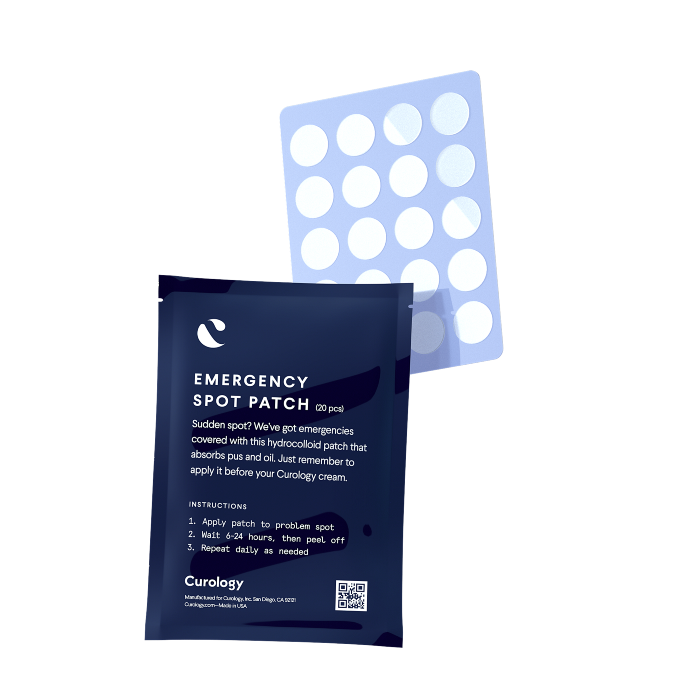How it works:
Share your skin goals and snap selfies
Your dermatology provider prescribes your formula
Apply nightly for happy, healthy skin
How it works:
How it works:
Share your skin goals and snap selfies
Your dermatology provider prescribes your formula
Apply nightly for happy, healthy skin
How it works:
Ask Curology: I popped a pimple! Now what?!
How to heal a popped pimple and help prevent acne scars



Medically reviewed by: Nancy Satur, MD
Written by: Curology Editorial Team
Welcome to Ask Curology, a series on the Curology blog where one of our in-house licensed dermatology providers answers your questions about all things skincare. Today we’re talking about how and when to pop pimples, which kinds of pimples you should absolutely not pop, and how to heal a pimple you’ve popped to help avoid infection and acne scars.
TL;DR: for best results, put a hydrocolloid bandage or pimple patch on it and be patient.
Dear Curology,
I know, I know… I wasn’t supposed to pop that zit, but I couldn’t help myself — it was so so big and gross, no amount of makeup could hide it. Now it’s all bloody and scabby and oozing some goo and I regret everything. I feel like Gob from Arrested Development: “I’ve made a huge mistake.”
Please help!
– Pimple Popper
Dear Pimple Popper,
Don’t worry, I’m not going to give you too hard of a scolding! Sure, we don’t want you to pick or squeeze pimples or blackheads for many reasons: it can cause scarring, infection, and even more acne breakouts.
The one pimple you should never, ever pop
There are certain kinds of pimples you never ever want to pop: deep, painful lesions (nodules). Attempting to pop these will hurt a LOT and won’t get you anywhere! They’re just too deep under the skin’s surface. Instead, an effective option for these types of lesions is often to see an in-person dermatologist for a cortisone injection. It may sound extreme, but it can help reduce scarring, and scarring is typically more common with those big, bad, deep-down pimples.
The best pimple popping alternative
Here’s a great alternative to popping zits: cover them with hydrocolloid bandages (also called acne patches, stickers, or dots). They help draw out the white gunk that’s clogging up the pore and speed up the healing process, too. Slap one on before you head to bed and leave it on for up to 24 hours. We make our own emergency spot patch here at Curology, and you can find other hydrocolloid bandages at your local drugstore. Head’s up — it’s best if you don’t apply any acne treatments right under the hydrocolloid bandage, as it could lead to irritation (plus, the bandage might not be able to stick to your skin).

Curology Emergency Spot Patch
If you’re looking for a low-profile patch that you can wear out and about, you can add our emergency spot patch to your skincare subscription. Our spot patch is ultra-thin and free of harsh active ingredients, so you (and everyone else) will barely notice you’re wearing one. If Curology isn’t for you, don’t worry! There are other hydrocolloid bandages out there.
If you’re gonna pop a pimple anyway…
In certain cases, it might be okay to pop a pimple — if it seems ready. How do you know a pimple is ready to be popped? This can be tricky, but generally, when a pimple has a “head” (white/yellow appearance), this is the pus right under the skin that will readily drain when popped. This isn’t exactly a medical term, but nothing describes it better than “juicy”! If it hurts to squeeze, or nothing comes out, it should be left alone. And if you start to see any bleeding from the popped spot, consider that a big red STOP sign!
The most important thing is to NOT use your fingers, and especially not your fingernails. To pop a zit, you can use a clean, small needle, or a sterile lancet (you can buy these at most drugstores) and prick the very tip of the pimple, with the needle parallel to the surface of the skin. Gently using these tools can prevent the pimple from accidentally exploding beneath the surface of the skin, which can lead to scarring.
Check out this derm-approved video tutorial on how to pop zits properly at acne.org (you can watch at 2x speed by going to the gearbox on the lower right corner of the video).
How to care for a popped pimple while it heals
After you’ve popped the zit, it could “fill up” again. Just when you think you’ve eradicated a zit, it can come back with a vengeance! Cover the spot with a hydrocolloid bandage (like we talked about above), such as NexCare Acne Patches, so the popped zit will heal nicely.
For even more info, check out our Guide to Big Zits.

Help prevent zits from popping up in the first place
Now that we’ve gotten the gory details out of the way, you’ll want to treat your skin to help prevent those big pimples from popping up in the first place. Sign up for a free trial of Curology and you’ll have a quick online consultation, get matched with a dermatology provider one-on-one, and receive your very own custom acne treatment. In the meantime, remember: hydrocolloid bandages are way better than popping!

We’re here to share what we know — but don’t take it as medical advice. Talk to your medical provider if you have questions.
Product Links: Empowering you with knowledge is our top priority. Our reviews of other brands’ products in this post are not paid endorsements—but they do meet our medically fact-checked standards for ingredients (at the time of publication).

Curology Team